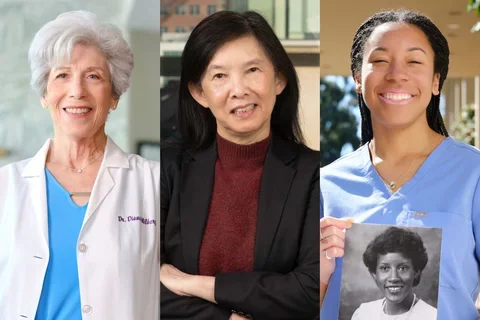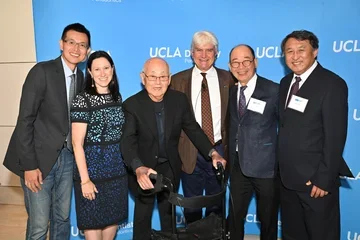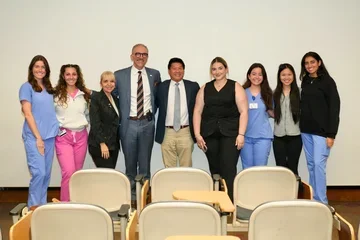Wonder Women: From the Margins to the Majority
Diane Milberg, D.D.S. '73, Anh Le, D.D.S. ’92, Ph.D./O.M.F.S. ’98, and Jordan Carfino, D.D.S. '24, represent three distinct eras of the School of Dentistry's gender evolution.

***This story appears in the UCLA School of Dentistry's Spring 2024 Magazine***
By Cyndy Lee Calverly
In 1897, a writer for the Los Angeles Herald warned that admitting women into what was then an all-male dental school would set a “dangerous precedent.” More than a century later, the demographics have flipped; the face of dentistry in this country has been transformed as the percentage of women enrolling in the nation’s dental schools has risen dramatically. In 2021, according to the American Dental Association Health Policy Institute, women made up 56% of first-year dental students, the highest rate in history at that time.
At the UCLA School of Dentistry that trend has only accelerated. Among its 24 students, the inaugural D.D.S. class of 1968 enrolled only one woman: Margaret Pan Quon, who remains actively engaged with the School to this day. In contrast, the recently-entering 2023 cohort of dental Bruins is 61% female and boasts the strongest academic credentials of any incoming class in school history.
The School's humanistic approach to dental education has made it a leading choice for women, as it has adopted and refined a curriculum that combines cutting-edge science with the application of critical thinking and principles of social equity. For many women, the seeds of highly successful careers as practitioners, researchers, and academicians were planted at the UCLA School of Dentistry. To mark the School’s 60th anniversary, we profile three alumnae at various stages of their professional journeys to discover how they found a pathway to success — an orthodontist (D.D.S. ’73) on the brink of retirement; a professor (D.D.S. ’92) who is one of the country’s brightest lights in oral and maxillofacial surgery; and a student (D.D.S. '24) with deep family ties to the School on the cusp of graduating.
Persevering and Reflecting: Diane Milberg, D.D.S. ’73
When Diane Milberg started dental school at UCLA in 1969 at age 20, she was the youngest student and one of only two women in a class of 96.
Starting dental school at that time was “akin to entering a well-established fraternity or men's club,” she said. Raised in a sheltered environment with little voice of her own, she found it intimidating to be a female in a macho world. She quietly inquired about what it would take to switch to medical school, a step that would have set her back two years.
It was a difficult time when women were beginning to break into male-dominated professions and had to put up with sexist remarks, unequal treatment, and sometimes boyish pranks meant to test their mettle. “That was the mentality back then,” she said. And it brought occasional days of tears shed in private.
“Part of it was on me, because I didn’t have the tools to deal with it, and part of it was on society at a time when the world was changing. I was caught in the transition,” Dr. Milberg said. “But I thought that if I am going to do this, I’m going to have to stick it out.”
And she did, surviving the first two years of challenging coursework that combined anatomy, histology, and pathology, among other topics, with a rigorous dental education. “The basic human biology we covered has given me an appreciation of how the many aspects of the body work together. Even to this day, I can understand the intricacies of new medical advances.”
The pass-fail system used at the time “encouraged cooperative learning in our class,” with upper-class female students like Jean Savage, D.D.S. ’71, and Teje Lindstrom, D.D.S. ’72 lending her a hand. She recalled that professors who worked part-time at UCLA while maintaining their own practices offered students “practical ‘pearls’ of knowledge,” that were much appreciated.
One experience left a lasting impression. Alongside classmates, Dr. Milberg traveled to an Arizona Navajo reservation, White River, to provide dental care to an underserved community. “I became very close to one of my patients and learned about her culture,” she said.
After earning her D.D.S., she headed for orthodontics residency training at the University of Washington, where she became only the second woman to be admitted into the program in a 30-year span.
In 1976 at age 27, she found herself as the only woman practicing orthodontics in the entire state of Washington. “Even when I started practicing, there were a lot of men who didn’t want to work with me because I was a woman,” she reminisced. Now in her 70s and living in San Diego, she works one morning a week at the orthodontic practice that her daughter, Laura, has now taken over from her. Dr. Milberg is a role model, not only to Laura but to several former patients who have also become dentists and even orthodontists.
She’s a longstanding member of the Edward Angle Society and a member of the American Association of Orthodontists. Dr. Milberg also helped plan the 50th-anniversary reunion of her UCLA class last year and rallied support for an endowed Class of 1973 scholarship. At their celebratory dinner, she grabbed the mic and did not hesitate to take some friendly jabs at her male majority classmates.
Looking back at her time in Westwood, she said, I feel I received an excellent education that gave me the basic tools to become an enthusiastic dental professional and enjoy my career.”
Changing Course: Anh Le, D.D.S. ’92, Ph.D./O.M.F.S. ’98
When Anh Le entered the UCLA School of Dentistry in September 1988, she had given birth to her second son less than a month before.
Some might call jumping into a rigorous, demanding academic program for a mom with a newborn a daunting challenge. But that didn’t stop Le from following her family’s agreed-upon course … which was for her husband to continue his residency in internal medicine while she would start training for a career that would offer a more flexible schedule to raise their two sons
“That was the plan,” Dr. Le now says with a laugh. “It didn’t turn out that way. I changed that career path when I entered UCLA.”
In her second year, she found that new goal. After presenting a case at a research lab meeting, Le was pulled aside by the then-chair of oral and maxillofacial surgery, Dr. Charles Bertolami. Alongside colleagues, he was launching a new sixyear program that combined an OMFS residency with a Ph.D. in oral biology.
He outlined a route that eventually led Le to become one of the country’s foremost oral surgery experts.
“From that time on, I knew what my career was going to be. I was completely hooked,” said Dr. Le, who also counts UCLA’s Drs. Diana Messadi and Earl Freymiller among her mentors.
“This was an important legacy that UCLA should be proud of. While people at the time were talking about building a pipeline to train academic surgeons, faculty at UCLA had the courage to establish it.”
On the heels of being voted the School’s “Woman of the Year in Dentistry” among her 1992 graduating D.S.S. class, Dr. Le became the first resident to enter this program, simultaneously conducting clinical research through a National Institute of Dental Research/National Institute of Health K08 grant.
“That was the best preparation for an academic career,” she said. While doing her residency, she felt she could never miss a day of work because her co-resident would have had to pick up the slack. “It was very challenging at that time. Now, with this new generation, they have more privileges and more flexibility. It has improved significantly.”
After holding faculty positions at Charles Drew University of Medicine and Science and the Herman Ostrow School of Dentistry of USC; today, she is the Norman Vine Endowed Professor and chair of the OMFS/Pharmacology Department at the University of Pennsylvania and a Penn Medicine oral surgeon. Her research focuses on investigating mesenchymal stem cells from adult oral tissues. With collaborators, she isolated and characterized adult stem cells from gingival tissue, a stellar achievement that has opened up new research pathways with the goal of regenerating craniofacial tissue.
While more women are entering dentistry, one survey found that only 12% to 15% choose oral surgery, she said. And the reason many say they don’t is the lack of mentors. Among her many professional affiliations, she is a fellow in the Hedwig van Ameringen Executive Leadership in Academic Medicine (ELAM) Program for Women. She was selected as the UCLA School of Dentistry’s Alumnus of the Year for 2023.
“I consider myself so fortunate to have met the right people. UCLA was the perfect fit for me. But I am also driven,” said Dr. Le, who worked in her family’s San Diego restaurant after immigrating to the U.S. from Vietnam. “We work hard. We learn to balance our work and life. And we never compromise on anything.”
A 40-Year Gap: Jordan Carfino, D.D.S. ’24
Jordan Carfino, once a pre-med major, could have gone in a different direction than her mother and grandfather, both dentists in private practice. She never felt pressured, she said
Ultimately, it was their love for their profession and her mother’s ability to deftly balance family and work that set her on the same path. Carfino will earn her D.D.S. at UCLA this June before joining Columbia University’s year-long Advanced Education in General Dentistry residency program.
“If I like dentistry half as much as they do, I’m going to be so content with my life,” Carfino said, smiling
Forty years before Jordan entered dental school among a female-majority student body, her mother, Dr. Toni Oliver-Carfino, enrolled at the UCLA School of Dentistry. Women comprised just a third of her 1984 D.D.S. class.
Dr. Oliver-Carfino felt her Bruin experience was enhanced by good advice, guidance, and encouragement from her classmates and faculty mentors, several of whom she’s still in touch with today. She was recently asked by one of her mentors, Associate Dean for Equity, Diversity, and Inclusion Dr. Edmond Hewlett, D.D.S. ’81, to serve on the new Black Alumni Association Board.
There are differences in the support system and the way students relate to each other, Dr. Oliver-Carfino said. These days, the School of Dentistry, for example, takes steps to encourage more women to pursue the profession and to create an environment where women feel welcome.
“I would say the support system for Jordan’s class is stronger; they are a more cohesive group. We had our little group, and we were still cohesive, but it feels like they are closer to each other than we were,” Dr. Oliver-Carfino opined.
Jordan also feels that one benefit of having so many female classmates is what they offer each other. “In certain stressful situations and for problem-solving, it’s great. Faculty-wise, I’ve had a number of women among my pre-clinical instructors. They always made it seem —not easy — but very manageable to do what they do, to have a family, and be able to excel in this profession.”
This mother-daughter team has some synergies in their School of Dentistry experience, each serving a term as president of UCLA’s chapter of the Student National Dental Association. The organization was founded in 1972 to support the success of minority dental students. The opportunities to network and just find mentors were important to both while at UCLA.
On June 2, their respective experiences will converge at the Class of 2024 Commencement Ceremony in Royce Hall. In a longstanding School tradition, alumni family members are invited to participate in the doctoral hooding ceremony.
“To me, it feels like the perfect full-circle moment,” Jordan said. “I got to grow up watching my mom in this profession, not realizing it was the profession I would one day be a part of. And while getting into dental school was this amazing accomplishment, I’m going to graduate from UCLA SOD just like her!
“I didn’t choose the school because of that but because it felt like the place I was also meant to be,” Jordan added. “It is just so special. Because I chose the same school, she gets to hood me and seal in this generational love of dentistry. I’m definitely going to cry.”



